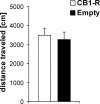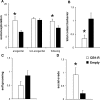AAV-Mediated Overexpression of the CB1 Receptor in the mPFC of Adult Rats Alters Cognitive Flexibility, Social Behavior, and Emotional Reactivity
- PMID: 21808613
- PMCID: PMC3139222
- DOI: 10.3389/fnbeh.2011.00037
AAV-Mediated Overexpression of the CB1 Receptor in the mPFC of Adult Rats Alters Cognitive Flexibility, Social Behavior, and Emotional Reactivity
Abstract
The endocannabinoid (ECB) system is strongly involved in the regulation of cognitive processing and emotional behavior and evidence indicates that ECB signaling might affect these behavioral abilities by modulations of prefrontal cortical functions. The aim of the present study was to examine the role of the CB1 receptor in the medial prefrontal cortex (mPFC) on cognitive flexibility and emotional behavior. Therefore, the CB1 receptor was overexpressed by adeno-associated virus vector-mediated gene transfer specifically in the mPFC of adult Wistar rats. Animals were then tested in different anxiety-related paradigms for emotional reactivity [e.g., elevated plus maze (EPM), light/dark emergence test (EMT), social interaction] and the attentional set shift task (ASST) - an adaptation of the human Wisconsin card sorting test - for cognitive abilities and behavioral flexibility. A subtle increase in exploratory behavior was found in CB1 receptor overexpressing animals (CB1-R) compared to Empty vector injected controls (Empty) in the EMT and EPM, although general locomotor activity did not differ between the groups. During social interaction testing, social contact behavior toward the unknown conspecific was found to be decreased, whereas social withdrawal was increased in CB1-R animals and they showed an inadequate increase in exploratory behavior compared to control animals. In the ASST, impaired reversal learning abilities were detected in CB1-R animals compared to controls, indicating reduced behavioral flexibility. In conclusion, upregulation of the CB1 receptor specifically in the rat mPFC induces alterations in emotional reactivity, leads to inadequate social behavior, and impairs cognitive flexibility. These findings might be relevant for neuropsychiatric disorders, since higher cortical CB1 receptor expression levels as well as similar behavioral impairments as observed in the present study have been described in schizophrenic patients.
Keywords: CB1 receptor; attentional set shift task; cognitive flexibility; emotional behavior; mPFC; social interaction.
Figures





Similar articles
-
Genetic deletion of monoacylglycerol lipase leads to impaired cannabinoid receptor CB₁R signaling and anxiety-like behavior.J Neurochem. 2015 Nov;135(4):799-813. doi: 10.1111/jnc.13267. Epub 2015 Sep 11. J Neurochem. 2015. PMID: 26223500
-
Morphological and behavioral evidence for impaired prefrontal cortical function in female CB1 receptor deficient mice.Behav Brain Res. 2014 Sep 1;271:106-10. doi: 10.1016/j.bbr.2014.05.064. Epub 2014 Jun 4. Behav Brain Res. 2014. PMID: 24907533 Free PMC article.
-
Cannabinoid CB1 receptors in the dorsal hippocampus and prelimbic medial prefrontal cortex modulate anxiety-like behavior in rats: additional evidence.Prog Neuropsychopharmacol Biol Psychiatry. 2015 Jun 3;59:76-83. doi: 10.1016/j.pnpbp.2015.01.005. Epub 2015 Jan 14. Prog Neuropsychopharmacol Biol Psychiatry. 2015. PMID: 25595265
-
Inducible Nitric Oxide Synthase Inhibition in the Medial Prefrontal Cortex Attenuates the Anxiogenic-Like Effect of Acute Restraint Stress via CB1 Receptors.Front Psychiatry. 2022 Jul 14;13:923177. doi: 10.3389/fpsyt.2022.923177. eCollection 2022. Front Psychiatry. 2022. PMID: 35911236 Free PMC article.
-
Perinatal Exposure to an Environmentally Relevant Mixture of Phthalates Results in a Lower Number of Neurons and Synapses in the Medial Prefrontal Cortex and Decreased Cognitive Flexibility in Adult Male and Female Rats.J Neurosci. 2018 Aug 1;38(31):6864-6872. doi: 10.1523/JNEUROSCI.0607-18.2018. Epub 2018 Jul 16. J Neurosci. 2018. PMID: 30012688 Free PMC article.
Cited by
-
Combinatorial approaches for treating neuropsychiatric social impairment.Philos Trans R Soc Lond B Biol Sci. 2022 Aug 29;377(1858):20210051. doi: 10.1098/rstb.2021.0051. Epub 2022 Jul 11. Philos Trans R Soc Lond B Biol Sci. 2022. PMID: 35858103 Free PMC article. Review.
-
Psilocybin targets a common molecular mechanism for cognitive impairment and increased craving in alcoholism.Sci Adv. 2021 Nov 19;7(47):eabh2399. doi: 10.1126/sciadv.abh2399. Epub 2021 Nov 17. Sci Adv. 2021. PMID: 34788104 Free PMC article.
-
The Effects of the Inhalant Toluene on Cognitive Function and Behavioral Flexibility: A Review of Recent Findings.Addict Neurosci. 2023 Mar;5:100059. doi: 10.1016/j.addicn.2022.100059. Epub 2022 Dec 22. Addict Neurosci. 2023. PMID: 36798693 Free PMC article.
-
From adolescence to late aging: A comprehensive review of social behavior, alcohol, and neuroinflammation across the lifespan.Int Rev Neurobiol. 2019;148:231-303. doi: 10.1016/bs.irn.2019.08.001. Epub 2019 Aug 24. Int Rev Neurobiol. 2019. PMID: 31733665 Free PMC article. Review.
-
Task-specific enhancement of hippocampus-dependent learning in mice deficient in monoacylglycerol lipase, the major hydrolyzing enzyme of the endocannabinoid 2-arachidonoylglycerol.Front Behav Neurosci. 2015 Jun 2;9:134. doi: 10.3389/fnbeh.2015.00134. eCollection 2015. Front Behav Neurosci. 2015. PMID: 26082696 Free PMC article.
References
-
- American Psychiatric Association (1994). Diagnostic and Statistical Manual of Mental Health Disorders (DSM IV). Washington, DC: American Psychiatric Press
-
- Bolla K. I., Brown K., Eldreth D., Tate K., Cadet J. L. (2002). Dose-related neurocognitive effects of marijuana use. Neurology 59, 1337–1343 - PubMed
LinkOut - more resources
Full Text Sources

